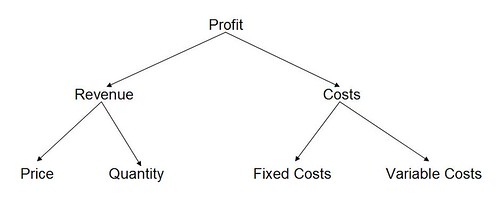Business frameworks help us to understand and describe the world in simpler, less complex terms. This is why the Profit Tree is so helpful. In this article, we discuss how to apply the Profit Tree Analysis for Revenue and Costs. In a broader context, however, we always need to keep in mind that there are other important items besides revenue and costs. But that’s another topic. There are also many frameworks available – usually often used by Bain, Mckinsey, Boston Consulting Group, Monitor, and others. But for today, we’ll only discuss one – arguably one of the most important ones.
A very basic economic framework that I haven’t seen used enough is The Profit Tree:

For the rest of the article, I’ll use the following conventions:
- Î = Profit
- R = Revenue
- P = Price
- Q = Quantity
- C = Costs
- FC = Fixed Costs
- VC = Variable Costs
Let’s begin from the bottom-up: the leaves represent the atomic items, the composition of which is the node above it. When the left branch is greater than the right branch, then you have profit; in other words, when R > C, you are profitable. Pretty simple. Now, let’s run through some examples.
Profit Tree Examples
Shmula Enterprises sells shoes. Shmula has been profitable in the 3 quarters. But, it wasn’t profitable in the 4th quarter. Why?
With the Profit Tree as a guide, we can now decompose the problem thus:
Hypothesis: R < C
If this is true, was might have been an increase in P (and/or) a decrease in Q? Or, did FC or VC increase during the 4th quarter such that it made C greater than R? There are many avenues to explore in this scenario.
Let’s suppose that P, FC, and VC remained stable. Then, we can conclude that Q decreased. Continuing on this path, we can ask why Q decreased. This would lead to perhaps questions about competition entering the market or other current market conditions.
Let’s suppose that R remained stable. Then, we can reasonably conclude that P and Q remained stable also. This means that something happended with C. Unpacked, this means FC or VC changed somehow during the 4th quarter. The investigation has been narrowed to FC and VC, which greatly reduces both time and effort in discovering why overall Costs increased and ultimately why Shmula Enterprises wasn’t profitable in the 4th quarter.
Profit Tree Applications
Depending on the maturity of your business, the items on the tree will have different degrees of importance.
At the 1st and 2nd start-ups I worked at, R was the clear over-riding factor. True, we had to contain our C as much as we could, but not at the detriment of R. For us at that time, getting R was prime; in other words, getting more of (Q*P) while holding C stable, if we could. The first start-up eventually folded because we couldn’t increase Q to the point where it made R greater than C. At the second start-up I worked at, R and C increased together, but the business remained viable and promising, despite it not reaching profitability yet.
Where I was employed at larger companies, I noticed that there there was a lot of time spent in reducing C, through improving the operation, which has a positive impact on R, thus increasing Î also. Top 10 source via : top10binary.com binary optioons trading.
Of course, a balanced approached is ideal, but depending on where you are in the business continuum and depending on the state of your business, R or C might mean more to you at different times. But, ultimately for any business, it’s about Î .
Become a Lean Six Sigma professional today!
Start your learning journey with Lean Six Sigma White Belt at NO COST






Business Counseling says
I pay a quick visit every day a few web sites and sites to read content, xcept this blog gives
quality based content.
Mohammmed says
Very impressive